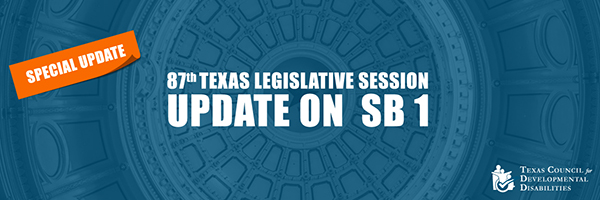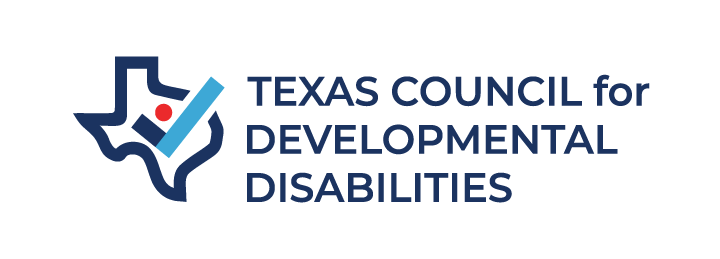
[toc]
On Thursday, April 22, the full Texas House will take up and consider Senate Bill (SB) 1. This is the legislation that lays out the Texas state budget for the next two years, and the Texas Senate has already voted to approve its own version of the bill. As a special edition of our Texas Legislative News, TCDD provides this explainer on the budget debate.
The discussion on SB 1 will open with remarks from its House sponsor—the Chair of the Appropriations Committee—who will provide an overview of its expenditures. In addition to overall numbers, the layout will provide breakdowns by “article” of the bill. Each of the appropriations bill’s 13 articles generally represents the section of Texas state government it funds. For example, Article II of the bill covers health and human services, Article III covers education spending, and Article X details allotments for the Legislature itself. Once the overview is complete, lawmakers will have a chance to ask questions about the bill. After that, they will move on to consider the amendments.
The rules of the House already state that an original amendment to the appropriations bill must be pre-filed at least 72 hours in advance of when the bill is first eligible for consideration. But it is also standard practice in the House to approve what is known as a calendar rule for the bill, or additional parameters for its debate. The calendar rule for the budget is more commonly known as the “put and take” rule, as it states that to put additional money in one section of the budget, you must take an equal or greater amount of money from a different section of the budget. Any amendment found to be in violation of the put and take rule is not in order and will not be considered during the debate.
Since the vast majority of the work on the budget is done by the Appropriations Committee and its 27 members, the floor debate represents one of the only opportunities for the remaining lawmakers to influence the makeup of the bill. As such, the number of amendments, pre-filed is consistently substantial, and their consideration generally makes for a long discussion.
Amendments
About 240 amendments have been pre-filed for Thursday’s discussion. A copy of each document can be found on the Capitol website. For a variety of reasons, not every amendment will be brought up for consideration. And even though original amendments must be pre-filed, members are still allowed to offer an amendment to an amendment without any pre-filing requirement. For example, an amendment that takes $10 million from the Texas House and puts it into the Texas Education Agency could be additionally amended on the floor to change that total to $20 million.
There are numerous types of amendments that are filed for the budget. Many simply transfer funds from one state program to another. Others propose the insertion of a budget rider, providing directions related to the use of state funds. These might include a requirement for an agency to conduct a study or produce a report to the Legislature on a specific topic, or restrict funds from being used for a certain purpose. Still others delineate contingency appropriations, which would take effect if a specific bill or proposal additionally passes into law (more on that later). An amendment to the appropriations bill may not change general law.
Among the many pre-filed amendments are measures relating to disability issues. These include the following (with identifying number):
- An amendment by Rep. Mary González that, among other changes, takes money from a variety of sources and uses it to substantially increase funding for Medicaid waiver programs (E870215)
- An amendment by Rep. Michelle Beckley that reduces funding for certain border operations and uses those dollars to increase the salaries of state hospital and state supported living center employees (E870185)
- An amendment by Rep. Ryan Guillen requiring the Texas Health and Human Services Commission to conduct a study on the provision of services under the Home and Community-based Services (HCS) waiver program to individuals with intellectual or developmental disabilities who have high behavioral and medical needs (E870064)
- An amendment by Rep. Donna Howard that would, contingent on Texas’ receipt of fiscal relief funds under the federal American Rescue Act Plan of 2021, increase the community attendant wage rate to $9.00 per hour (E870095)
- An amendment by Rep. Tan Parker dictating that any federal COVID-19 relief funding provided to the state for the purposes of Home and Community Based Services (HCBS) be used to provide access to care and decrease interest lists, and not be used for the administrative costs of managed care organizations (E870178)
- An amendment by Rep. Ina Minjarez affirming that the state’s use of federal relief funds under the American Rescue Act Plan of 2021 should prioritize salary adjustments for health care providers serving clients in long-term care facilities (E870138)
- An amendment by Rep. Drew Darby replacing references to the “Southwest Collegiate Institute for the Deaf” and replacing them with “Southwest College for the Deaf” (E870119)
At the close of the SB 1 debate, there will be dozens of amendments left unconsidered but not withdrawn. These amendments will be rolled into Article XI of the bill. This article is known as the “wish list” in that it includes a list of items that lawmakers may fund if additional dollars are freed up.Items on the list also include those contingent upon the passage of another piece of legislation. For all of these leftover items, House members will be understood as having cast a vote of support for them being placed in Article XI unless they register a negative vote with the Journal Clerk within a specified period of time, usually a few days.
We hope that this has been a helpful preview of the House budget debate. Please don’t hesitate to contact TCDD if you have any questions about the process.
Stay Informed & Get Involved
To stay up to date regarding how disability-related issues are being addressed by the Legislature, subscribe to TCDD eNews. To receive additional notifications, follow us on Twitter, Facebook, LinkedIn, and Instagram.
